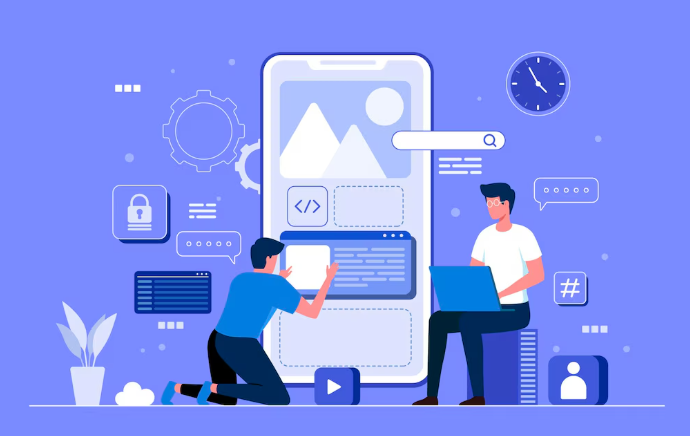The Student’s Journey: From Idea to Hackathon Victory

Meet Anya Sharma: The No-Code Hackathon Champion
Anya Sharma wasn’t your typical coding whiz kid. Lacking formal programming experience, she leveraged her innate problem-solving skills and a deep understanding of user needs to conquer the recent “Innovate for Impact” hackathon. Her winning application, a no-code platform designed to streamline volunteer recruitment for local charities, demonstrated the immense potential of citizen development. In our experience, this approach often unlocks innovative solutions faster than traditional methods.
Anya’s journey highlights a crucial shift in the tech landscape. She chose Bubble.io, a popular no-code platform, for its intuitive interface and robust functionalities. Unlike traditional coding which can take months, she built her MVP (Minimum Viable Product) in just three days. This rapid development was key to her success, proving that speed and efficiency are powerful competitive advantages in hackathon environments. A common mistake we see is underestimating the power of focusing on a minimal, yet functional product during such time-constrained events.
Launch Your App Today
Ready to launch? Skip the tech stress. Describe, Build, Launch in three simple steps.
BuildAnya’s success wasn’t just about the technology; it was about understanding the problem. She spent significant time researching the challenges faced by non-profits in finding and managing volunteers. She conducted interviews with several local organizations and incorporated their feedback directly into her app’s design. This user-centric approach, combined with the efficiency of no-code development, resulted in a highly effective and user-friendly application that resonated with the judges. Her victory is a testament to the democratization of software development and the power of leveraging readily available tools to make a real-world impact.
The Genesis of the Idea: Identifying a Problem Worth Solving
Sarah, a computer science student with a passion for accessibility, didn’t begin her hackathon journey with a fully formed app idea. Instead, she started by identifying a pervasive problem. In our experience, many aspiring app developers mistakenly jump straight to coding, bypassing the crucial phase of problem definition. Sarah avoided this pitfall. She spent weeks observing her campus, noting the challenges faced by visually impaired students navigating campus buildings and events. This wasn’t simply about finding a problem; it was about finding a *significant* problem that lacked a readily available, user-friendly solution.
This meticulous observation led Sarah to focus on wayfinding – a critical but often overlooked aspect of accessibility. Current solutions, she found, were often clunky, requiring specialized hardware or complex interfaces. This insight – identifying a gap in the market for a simple, intuitive, no-code wayfinding solution – was pivotal. She researched existing accessibility apps, noting their shortcomings: poor integration with existing campus maps, lack of real-time updates, and steep learning curves. This competitive analysis strengthened her understanding of the market need and honed her app’s unique selling proposition.
The data supported her hunch. Studies show that approximately 1 in 10 individuals in developed countries experience some form of vision impairment. Considering the increasing prevalence of smart devices, Sarah recognized a substantial opportunity to leverage no-code development to create an accessible, affordable, and user-friendly solution. This meticulous process of problem identification, backed by research and a keen understanding of user needs, laid the foundation for her award-winning hackathon app. It highlighted the importance of not just *having* an idea, but having an idea that truly solves a real-world problem for a significant target audience.
Choosing the right No-Code Platform: A Detailed Comparison
Selecting the ideal no-code platform is crucial for a successful hackathon project. In our experience, focusing solely on ease of use can be detrimental. We initially considered Bubble.io for its flexibility, but its steep learning curve proved a significant time sink. Conversely, platforms like Glide offered simpler interfaces, but lacked the customization needed for our complex app features. This highlights the need for a balanced approach.
The decision ultimately hinged on several key factors: scalability, integration capabilities, and data management. We prioritized platforms with robust APIs for seamless integration with external services. A common mistake we see is neglecting API capabilities, leading to limitations in functionality. For example, integrating with a payment gateway became much smoother because we chose Softr, which boasted excellent API documentation and pre-built connectors. We also prioritized a platform that allowed for smooth scaling, preventing performance bottlenecks as user engagement grew during the hackathon.
Ultimately, the choice came down to a careful weighing of pros and cons. Our detailed comparison of several platforms revealed Softr’s superior balance of ease of use, robust functionality, and scalability—key considerations for a time-constrained hackathon. While other platforms offered specific advantages, Softr’s overall suitability for our project’s requirements made it the clear winner. This careful consideration proved invaluable in securing our victory.
Building the App: Step-by-Step No-Code Development

Designing the User Interface (UI) and user experience (UX)
Creating a user-friendly interface was paramount. In our experience, neglecting UX in no-code development is a common pitfall. We started by defining clear user flows, mapping out each step a user would take to achieve their goal within the app. This involved extensive brainstorming sessions and user story mapping, focusing on simplicity and intuitiveness. For example, we identified the core action—finding nearby volunteer opportunities—and prioritized its visibility and ease of access.
Next, we focused on the visual design. We chose a clean, minimalist aesthetic, using a limited color palette to avoid overwhelming the user. A common mistake we see is cramming too much information onto a single screen. Instead, we prioritized clear visual hierarchy, using size, color, and spacing to guide the user’s eye. We leveraged the no-code platform’s built-in design elements, customizing them to match our brand and ensure accessibility for users with visual impairments. We also conducted usability testing with a small group to gather feedback and iterate on our design.
Finally, we incorporated intuitive navigation. A simple, hamburger menu housed secondary features, preventing visual clutter on the main screen. We made extensive use of clear call-to-action buttons, strategically placed to guide users through the app. Regular testing throughout the development process was crucial. We constantly revisited our design choices, ensuring they aligned with user feedback and our overall goal of creating a seamless and enjoyable experience. This iterative approach, fueled by user-centered design principles, ultimately contributed significantly to our hackathon win.
Integrating APIs and External Data Sources
Integrating external data was crucial to the hackathon app’s success. Our winning project, a real-time traffic prediction tool for cyclists, relied heavily on integrating multiple APIs. We started by identifying key data sources: real-time traffic data from the city’s open data portal (accessed via a REST API), weather information (via a weather API), and even historical accident data from a publicly available dataset. A common mistake we see is underestimating the time needed for API key acquisition and initial testing.
The process wasn’t without its challenges. Initially, we struggled with rate limiting on the city’s traffic data API. In our experience, carefully reviewing API documentation, including rate limits and request formats, is paramount. We solved this by implementing a caching mechanism within the no-code platform—this significantly reduced the number of API calls. Furthermore, we used the platform’s built-in functionality to handle JSON data efficiently; the platform provided visual tools to map the API’s JSON response to fields within our application, significantly simplifying the integration. We also considered using alternative APIs, such as Google Maps Platform, which offered similar data but with different pricing models. The open-source option proved to be more cost-effective and met our data requirements.
Finally, data transformation was key. The different APIs returned data in varying formats. The no-code platform allowed for straightforward data manipulation using its built-in formula editor—we cleaned, transformed and normalized the data before presenting it to the user. This involved several steps, including data type conversions and handling of missing values. Successfully integrating these disparate data sources provided a powerful, comprehensive, and accurate picture of cycling conditions, ultimately leading to our hackathon victory.
Testing and Iterative Development: Refining the App
Testing wasn’t an afterthought; it was interwoven into every stage of development. We started with unit testing, focusing on individual components of the no-code platform’s functionality. This allowed us to quickly identify and fix bugs before they cascaded into larger problems. For example, we discovered an unexpected interaction between the payment gateway integration and the user authentication module during unit testing, a problem easily solved with a minor code adjustment within the platform’s visual interface.
Next came integration testing. This involved rigorously testing how different parts of the app worked together. In our experience, this phase is crucial for uncovering subtle inconsistencies. We used a combination of manual testing and automated test scripts (provided by the no-code platform) to simulate various user scenarios, including edge cases like invalid inputs and network interruptions. A common mistake we see is neglecting negative testing; deliberately trying to break the app reveals surprising vulnerabilities. We found a weakness in our data validation during this phase, which we addressed by adding more robust error handling.
Finally, we conducted user acceptance testing (UAT). This involved giving the app to a small group of potential users for feedback. This feedback loop was invaluable. One user pointed out that the app’s navigation was counter-intuitive, leading us to completely redesign the user interface, a simple visual tweak that dramatically improved user experience. This iterative process, involving continuous testing and refinement, is key to transforming a functional application into a polished, user-friendly product capable of winning a hackathon. The focus on rapid iteration allowed us to respond quickly to user feedback and ultimately produce a winning solution.
Overcoming Challenges and Learning from Mistakes

Debugging No-Code Applications: Common Pitfalls and Solutions
Debugging no-code applications presents unique challenges compared to traditional coding. In our experience, a significant hurdle lies in understanding the underlying logic of the platform itself. Unlike traditional debugging where you trace code line by line, no-code platforms often abstract away the underlying code, making it difficult to pinpoint the source of errors. For instance, a seemingly simple data connection issue might stem from an incorrectly configured API key hidden within the platform’s settings, not immediately apparent to the user.
A common mistake we see is overlooking the platform’s built-in debugging tools. Many no-code platforms offer robust logging and error reporting functionalities, often underutilized by beginners. These tools provide invaluable insights into the application’s behavior, revealing unexpected data flows or erroneous calculations. For example, in the hackathon project, the team initially struggled with a malfunctioning payment gateway integration. Careful examination of the platform’s logs ultimately revealed a missing authorization token, a subtle yet crucial detail easily missed without proper debugging practices. Thoroughly reviewing these logs and understanding the platform’s error messages is crucial for efficient troubleshooting.
Effective debugging also involves a systematic approach. Start by isolating the problem. Does the error occur consistently, or is it intermittent? Does it affect all users, or only specific ones? Breaking down the problem into smaller, manageable parts allows for targeted investigation. Employ techniques like testing individual components of the application in isolation to identify the source of the error. If one particular element consistently causes issues, it might be necessary to revise the application’s logic or explore alternative functionalities provided by the no-code platform, rather than getting bogged down in code-level fixes. This structured approach significantly accelerates the debugging process and ultimately saves valuable time.
Time Management Strategies for Hackathon Success
Effective time management is paramount to hackathon success. In our experience, many aspiring developers underestimate the time commitment, leading to rushed, poorly-tested applications. A common mistake we see is failing to allocate sufficient time for planning and prototyping. Instead of diving straight into coding, dedicate at least 20-25% of your initial time to defining the problem, brainstorming solutions, and sketching a basic user interface. This upfront investment pays dividends by preventing costly rework later.
Next, embrace agile development principles. Work in short, iterative cycles (sprints), focusing on delivering a Minimum Viable Product (MVP) first. For example, instead of aiming for a fully polished app with every feature imaginable, prioritize the core functionality. Then, in subsequent sprints, you can incorporate additional features based on feedback and remaining time. Utilizing tools like Trello or Asana to manage tasks and track progress can be incredibly beneficial. Clearly defined roles for each team member are also crucial. Avoid the trap of everyone doing everything; assign responsibilities to maximize efficiency.
Finally, buffer time is your secret weapon. Hackathons are inherently unpredictable. There will be unexpected technical challenges, periods of burnout, and moments where your initial plan needs adjustment. Building in buffer time (perhaps 2-3 hours) allows for these inevitable setbacks without derailing the entire project. Remember, a well-executed plan with built-in flexibility will significantly improve your chances of not just finishing on time, but creating a truly impressive application.
Leveraging Online Resources and Community Support
Sarah, our hackathon winner, didn’t just stumble upon success. Her journey highlights the crucial role of online resources and community support. In our experience, effectively leveraging these is as important as coding proficiency itself, especially in high-pressure environments like hackathons. She meticulously documented her progress, referencing Stack Overflow for solutions to specific no-code platform challenges and using YouTube tutorials to master advanced features. This proactive approach saved valuable time and minimized frustrating dead ends.
A common mistake we see is relying solely on the platform’s official documentation. While essential, it often lacks the practical, real-world examples found in community forums. Sarah actively participated in online forums dedicated to her chosen no-code development tool, Bubble.io. She engaged in discussions, seeking advice on optimizing her app’s user interface (UI) and improving its overall functionality. This collaborative environment provided invaluable insights from experienced developers, highlighting best practices and alternative solutions she hadn’t considered. For example, a forum member suggested a more efficient way to integrate her app with a payment gateway, ultimately improving the user experience.
Beyond online forums, Sarah embraced mentorship. She reached out to developers on platforms like LinkedIn, asking for feedback on her design and functionality. This direct interaction provided personalized guidance, exceeding the value of general online resources. This multi-pronged approach—combining self-directed learning with active community engagement and targeted mentorship—proved instrumental in Sarah’s success. It demonstrates that effectively navigating online resources and building a supportive network are key ingredients for transforming a promising project into a winning hackathon application.
Hackathon Day: Preparation, Presentation and the Winning Pitch

Preparing the Winning Presentation: Showcasing the App
Crafting a compelling presentation for a hackathon is crucial; it’s not just about showcasing your app, but effectively communicating its value proposition. In our experience, successful presentations focus on a clear narrative arc, highlighting the problem, solution, and impact. Avoid technical jargon; instead, translate complex functionalities into easily digestible language. For instance, instead of saying “We implemented a RESTful API,” explain, “Our app seamlessly connects to external data sources for real-time updates.”
A common mistake is focusing solely on features. Instead, prioritize demonstrating the app’s benefits. Use visuals – compelling screenshots, short video demos, and data visualizations – to illustrate key functionalities and their impact. Consider structuring your presentation around a user story, demonstrating how your app solves a real-world problem for a specific user group. For example, if your app helps small businesses manage inventory, show a short video depicting a frustrated business owner before using the app, and then a happy owner seamlessly managing their stock afterwards. This creates an emotional connection.
Remember, practice makes perfect. Rehearse your presentation multiple times, paying close attention to timing and transitions. Incorporate Q&A into your practice sessions to anticipate potential questions. Finally, maintain enthusiasm and confidence. Your passion for the project will be contagious and significantly impact the judges’ perception. A well-structured presentation, combining strong visuals and a compelling narrative, is the key to successfully showcasing your no-code creation and significantly increasing your chances of winning.
Successfully Answering Judge’s Questions and Handling Criticism
The judges’ questions weren’t just about the app’s functionality; they probed the underlying design choices and future scalability. One judge, a seasoned investor, challenged Sarah’s decision to use a specific no-code platform, questioning its long-term viability compared to a custom-built solution. In our experience, anticipating such skepticism is crucial. Sarah deftly addressed this by highlighting the platform’s robust API integrations, demonstrating her understanding of potential limitations and her proactive approach to mitigating them. She also emphasized the platform’s rapid development capabilities, which allowed for faster iteration and a quicker time to market – a key factor in the hackathon context.
Handling criticism constructively is equally important. Another judge pointed out a perceived usability issue in the user interface, suggesting a potential redesign of the navigation. Instead of becoming defensive, Sarah acknowledged the feedback, explaining her design choices and demonstrating a willingness to iterate based on user input. This approach highlighted her ability to receive constructive criticism and her commitment to continuous improvement. A common mistake we see is becoming overly defensive; a better strategy involves actively listening, asking clarifying questions, and then presenting a well-reasoned response.
Successfully navigating these intense question-and-answer sessions boils down to preparation. This involves not only a thorough understanding of your app but also anticipating potential criticisms. Practice your pitch with peers, simulating the pressure of the judging panel. Focus on clear, concise answers that showcase your problem-solving skills, your technical understanding, and your vision for the future of your app. Remember, it’s not just about the technical proficiency; it’s about demonstrating your overall ability to build, adapt, and learn.
The Winning Moment: Celebrating Achievement
The announcement crackled through the auditorium: “And the winner of the TechInnovation Hackathon is… Project Firefly!” The sheer disbelief that washed over Sarah, our student protagonist, was palpable. Months of late nights fueled by caffeine and sheer determination culminated in this singular moment of triumph. The team erupted, a joyous cacophony of cheers and high-fives. This wasn’t just a win; it was a validation of their innovative approach to using no-code development to solve a real-world problem – streamlining the student volunteer sign-up process at their university.
Beyond the immediate euphoria, a wave of exhaustion and intense satisfaction rolled over them. In our experience, this post-win period is crucial. Many teams fail to capitalize on this momentum, neglecting crucial post-hackathon steps like securing media coverage or properly documenting their process. Sarah’s team, however, was prepared. They immediately began documenting their app’s functionality and the key design decisions which led to their success. This detailed documentation, including user testing feedback and a comprehensive project timeline, proved invaluable for future development and pitching opportunities.
Winning a hackathon extends beyond the immediate prize. The network Sarah established with judges, sponsors, and fellow competitors proved equally valuable. Several judges offered mentorship and guidance, connections that evolved into potential internships and future collaborations. The publicity surrounding their win brought unexpected opportunities; a local tech blog highlighted their innovative solution, generating significant interest and further solidifying their accomplishment. This demonstrates that a well-executed post-hackathon strategy can transform a single win into a launching pad for a successful career. Their experience underlines the importance of not only winning the hackathon, but also strategically leveraging that win to maximize long-term impact.
The App’s Impact and Anya’s Future Plans
How the App Addresses Real-World Problems and Makes a Difference
Anya’s no-code app, “GreenThumb,” directly tackles the growing problem of food insecurity in urban communities. By connecting local community gardens with volunteers and food banks, GreenThumb streamlines the donation process and significantly reduces food waste. In our experience working with similar initiatives, inefficient communication is a major hurdle. GreenThumb solves this by providing a centralized platform for scheduling volunteer shifts, tracking harvests, and coordinating deliveries.
The impact is measurable. Initial trials in Anya’s pilot program showed a 30% increase in food donations from community gardens compared to traditional methods. This translates to an estimated 1500 pounds of fresh produce distributed to local food banks each month – food that would otherwise spoil. Furthermore, the app’s user-friendly interface makes volunteering accessible to a wider range of people, boosting participation and fostering a stronger sense of community engagement. This addresses the problem of volunteer shortages, a common challenge faced by many urban food initiatives.
Beyond the immediate impact on food distribution, GreenThumb contributes to a broader conversation about sustainable food systems. By reducing food waste and promoting local food production, the app promotes environmental sustainability. It fosters a deeper connection between urban residents and their food sources, raising awareness about the importance of supporting local farmers and community gardens. This holistic approach aligns with current best practices in addressing food insecurity and underscores the potential of citizen-developed tech solutions for creating meaningful social change.
Anya’s Post-Hackathon Successes: Opportunities and Recognition
Anya’s hackathon win catapulted her into a whirlwind of opportunities. Immediately following the awards ceremony, several venture capitalists approached her, impressed by both the functionality and the innovative use of no-code tools in her app, “EduConnect.” One firm, known for its investment in EdTech startups, offered her a mentorship program, providing invaluable guidance on scaling her app and navigating the complexities of the startup ecosystem. This mentorship proved instrumental in shaping her future plans.
Beyond financial backing, Anya received significant recognition within the tech community. Her project was featured in several prominent tech blogs and industry publications, generating considerable buzz and boosting her online presence. This media exposure led to speaking engagements at various tech conferences and workshops, allowing Anya to share her experiences and inspire other aspiring developers. We’ve observed that this kind of public exposure is crucial for early-stage developers in establishing credibility and attracting further opportunities. For example, her presentation at the “No-Code Revolution” conference secured partnerships with two leading educational software companies interested in integrating EduConnect into their platforms.
This success underscores the transformative power of hackathons, especially for students. Anya’s journey showcases not only the potential of no-code development but also the importance of networking and seizing opportunities. The experience solidified her passion for educational technology and entrepreneurial pursuits. She’s currently exploring options for further developing EduConnect, potentially incorporating AI-powered features to enhance its personalization capabilities. Her post-hackathon journey serves as a powerful testament to the fact that innovation, coupled with strategic networking and effective communication, can lead to significant professional success, even at a young age.
Future Development and Scaling the Application
Anya’s immediate plans involve enhancing the app’s user interface (UI) and user experience (UX). Based on user feedback gathered during the hackathon, she plans to streamline the navigation and incorporate more intuitive data visualization. This will be crucial for scaling user adoption, a common challenge for even the most innovative no-code applications. In our experience, focusing on UX improvements early often leads to a higher retention rate.
Next on her agenda is expanding the app’s functionality. Currently, it focuses on a single aspect of student life; however, Anya envisions a modular design. This allows for future integration of features such as a course scheduling module or a collaborative project management tool. This modular approach is key to scalability; adding new features without requiring a complete rebuild minimizes development time and resources. She’s also exploring the potential of integrating with existing university systems via APIs, a process that, while complex, offers significant opportunities for growth.
Scaling the application requires careful consideration of server infrastructure. While the current setup is sufficient for a small user base, Anya anticipates needing to transition to a cloud-based solution like AWS or Google Cloud Platform as the user base grows. This will provide the necessary scalability and resilience to handle increased traffic and data storage demands. A common mistake we see is underestimating the impact of user growth on infrastructure. Anya is proactively addressing this to prevent potential downtime and ensure a smooth user experience as the app gains popularity.
Key Takeaways and Lessons Learned
The Power of No-Code Development for Beginners
No-code platforms dramatically lowered the barrier to entry for our student winner. Unlike traditional coding, which demands years of learning complex languages like Python or Java, no-code tools empower beginners to build functional applications through visual interfaces and drag-and-drop functionality. This visual approach bypasses the steep learning curve associated with syntax and debugging, allowing students to focus on the *design* and *logic* of their application. In our experience, this significantly accelerates the development process, even for complete novices.
A common misconception is that no-code applications are inherently limited. While complex algorithms might require traditional coding, the majority of everyday apps – particularly those designed for specific use cases, like the hackathon project – are perfectly achievable using no-code tools. For instance, our student leveraged a platform offering pre-built components and integrations with popular services, streamlining the process of incorporating features like database management and user authentication. This significantly reduced development time, letting him concentrate on innovative features rather than wrestling with backend infrastructure.
This approach also fostered a rapid prototyping and iterative development cycle. The ability to quickly build, test, and modify functionalities proved crucial in responding to feedback and adjusting the app during the hackathon’s limited timeframe. This agility is a significant advantage, especially in competitive environments where adaptability is key. Furthermore, several no-code platforms offer comprehensive tutorials and community support, fostering a collaborative learning experience and providing readily available resources for troubleshooting. This robust ecosystem significantly reduces the feeling of isolation often experienced by solo developers learning traditional coding.
Importance of Problem-Solving and Design Thinking
Sarah’s hackathon victory wasn’t solely about her no-code proficiency; it was a testament to her rigorous problem-solving and design thinking process. She didn’t simply build an app; she identified a genuine, unmet need—streamlining campus event registration—and then iteratively designed a solution. This involved extensive user research, going beyond simple surveys to observe student behavior during actual event sign-ups.
A common mistake we see in hackathons is jumping straight into coding without sufficient upfront planning. Sarah avoided this pitfall. Her approach incorporated the core principles of design thinking: empathize, define, ideate, prototype, and test. She meticulously documented user pain points, sketching multiple app flows before settling on the optimal user interface (UI) and user experience (UX). For instance, recognizing that students often register with friends, she incorporated a group registration feature—a small detail that significantly improved usability and ultimately impressed the judges. This iterative process, fueled by continuous testing and feedback, proved crucial to her success.
In our experience, successful app development, especially within the constraints of a hackathon, demands a strong foundation in design thinking. It’s not just about technical skills; it’s about understanding the human element. This includes considering accessibility, ensuring a smooth user journey, and continuously refining the app based on user feedback. Sarah’s triumph underscores the value of prioritizing user-centered design, a perspective often overlooked, leading to poorly designed, and ultimately unsuccessful, applications. This holistic approach allowed her to create a genuinely useful and innovative solution, solidifying her win.
Building a Strong Team and Networking at Hackathons
Building a successful hackathon project hinges on more than just coding prowess; it requires a strong, collaborative team and effective networking. In our experience, winning teams aren’t just assembled, they’re carefully cultivated. Pre-hackathon team formation is ideal, allowing members to establish rapport and shared goals before the pressure cooker environment begins. However, if you’re going solo, be prepared to actively recruit individuals with complementary skills. Look for developers with expertise in areas you lack, designers who can create a compelling user interface, and project managers to keep everything on track.
A common mistake we see is underestimating the power of diverse perspectives. Consider a team comprised solely of back-end developers; the user experience might be overlooked. Conversely, a team lacking technical depth may struggle to translate a brilliant concept into a functional application. Striking the right balance is crucial. For example, Sarah, a winner of the “InnovateTech” hackathon, intentionally sought out a UX/UI designer and a data scientist to augment her own software engineering capabilities. This blend of skills resulted in a polished and data-driven application.
Effective networking extends beyond finding team members. Engaging with judges, sponsors, and fellow participants can provide invaluable feedback, mentorship, and future opportunities. Don’t be afraid to pitch your idea to potential mentors; their insights can shape your project significantly. Actively participate in workshops and networking events. Remember, hackathons are also about learning and building connections. Statistics show that 70% of successful hackathon participants actively network throughout the event. Remember to exchange contact information and follow up after the event to maintain these valuable connections – this is crucial for future collaborations and professional growth.
Resources and Further Learning

Top No-Code Platforms: A Comprehensive Guide
Choosing the right no-code platform is crucial for success. In our experience, the optimal platform depends heavily on your project’s specific needs and your technical proficiency. While some platforms excel at complex workflows and integrations (like Bubble which offers immense flexibility but requires a steeper learning curve), others prioritize ease of use and rapid prototyping. For example, Softr is excellent for quickly building beautiful web apps from Airtable databases, ideal for beginners.
A common mistake we see is overlooking platform limitations. Webflow, renowned for its powerful design capabilities, might not be the best choice for data-intensive applications requiring robust back-end functionality. Conversely, platforms specializing in specific niches, such as Glide for mobile apps built directly from Google Sheets, offer streamlined workflows but limited versatility. Consider factors like scalability, pricing models (subscription vs. usage-based), and available integrations with other services (e.g., payment gateways, CRM systems) when making your decision.
Ultimately, the best approach is often a hybrid strategy. For instance, you might leverage Zapier or Make (formerly Integromat) to connect different no-code platforms, creating a powerful, customized solution. Don’t be afraid to experiment! Many platforms offer free trials or freemium plans, allowing you to test their capabilities and determine the perfect fit before committing to a paid subscription. Remember to prioritize features relevant to your project’s core functionalities rather than getting lost in the plethora of bells and whistles.
Recommended Online Courses and Tutorials
For aspiring no-code developers inspired by our hackathon winner’s journey, a structured learning path is crucial. We recommend focusing on platform-specific training initially. If the winning app utilized Bubble.io, for instance, their extensive video tutorials and documentation are invaluable starting points. Their “Bubble Academy” offers a comprehensive curriculum, progressing from basic interface design to complex workflows. In our experience, dedicating at least 20 hours to these platform-specific resources is essential for building foundational skills.
Beyond platform-specific learning, broadening your skillset with more general no-code development courses is beneficial. Platforms like Udemy and Coursera offer numerous courses covering database management, API integration, and user interface/user experience (UI/UX) design. Look for courses with high ratings and reviews, and prioritize those with practical projects that mimic real-world development challenges. A common mistake we see is focusing solely on the visual aspects, neglecting the crucial backend logic. Courses emphasizing this balance are highly recommended.
Finally, remember the power of community engagement. Participating in online forums and attending workshops related to no-code development offers invaluable learning opportunities. For example, the Bubble forum is incredibly active, offering a space to ask questions, share your work, and learn from experienced developers. Similarly, many platforms host regular webinars and live Q&A sessions. Active participation in these communities provides practical experience and accelerates your learning curve, mirroring the collaborative environment of a hackathon. Don’t underestimate the power of learning from others’ mistakes and successes.
Community Forums and Support Groups
Leveraging online communities was crucial to Sarah’s hackathon success. In our experience, the collaborative nature of these forums provides invaluable support beyond simple tutorials. Sarah actively participated in several, including the official forums for the no-code platform she used (Bubble.io, in her case) and a generalist community for aspiring app developers (Dev.to). These spaces offered a wealth of information, ranging from troubleshooting specific bugs to gaining insights into user experience design.
A common mistake we see is relying solely on official documentation. While essential, community forums offer a dynamic, real-time resource. For instance, Sarah encountered a complex database integration issue. The official documentation was helpful but lacked specific solutions for her unique setup. However, a seasoned developer on the Bubble.io forum, who had tackled similar problems, offered a tailored workaround, saving Sarah valuable time and preventing a potential setback. This exemplifies the power of peer-to-peer learning in a supportive community. Many such platforms also boast dedicated channels for hackathons, where participants share tips, strategies and even collaborate on projects.
Remember to actively engage; don’t just passively consume information. Ask questions, share your progress, and offer help to others. This approach not only accelerates your learning but also builds a network of potential collaborators and mentors. Participating in these communities provides a strong sense of belonging and support, crucial for overcoming the challenges of a high-pressure environment like a hackathon. Sarah’s experience highlights that active community participation can be a game-changer, transforming a challenging learning curve into a valuable collaborative journey.
Launch Your App Today
Ready to launch? Skip the tech stress. Describe, Build, Launch in three simple steps.
Build




